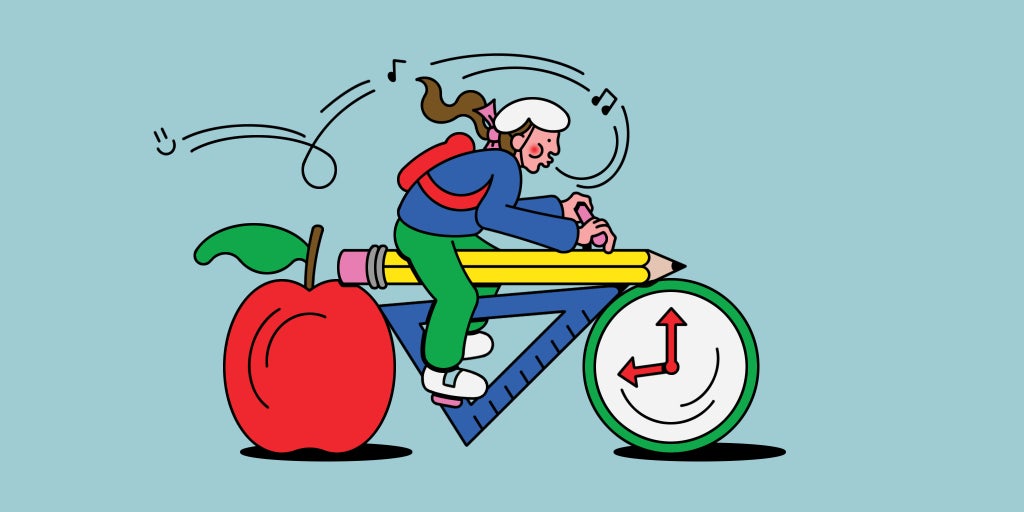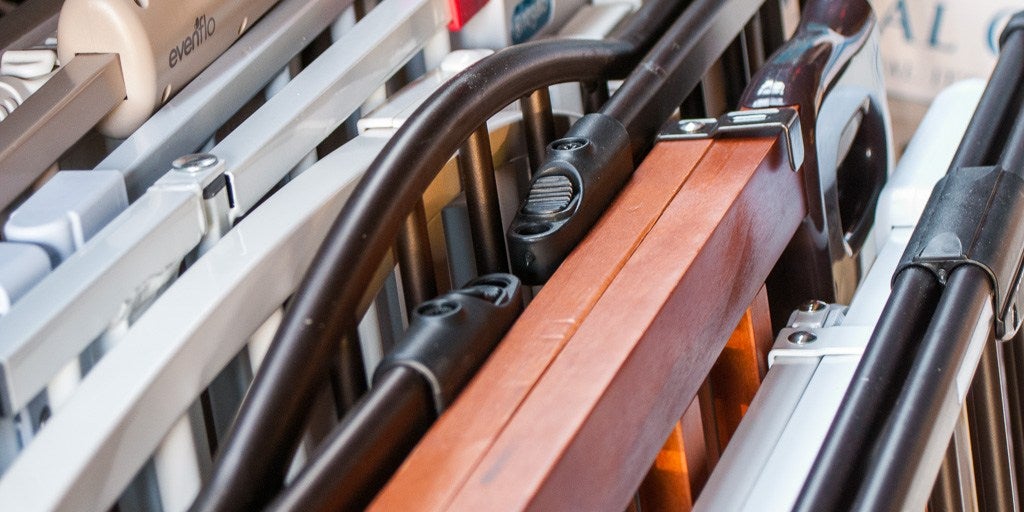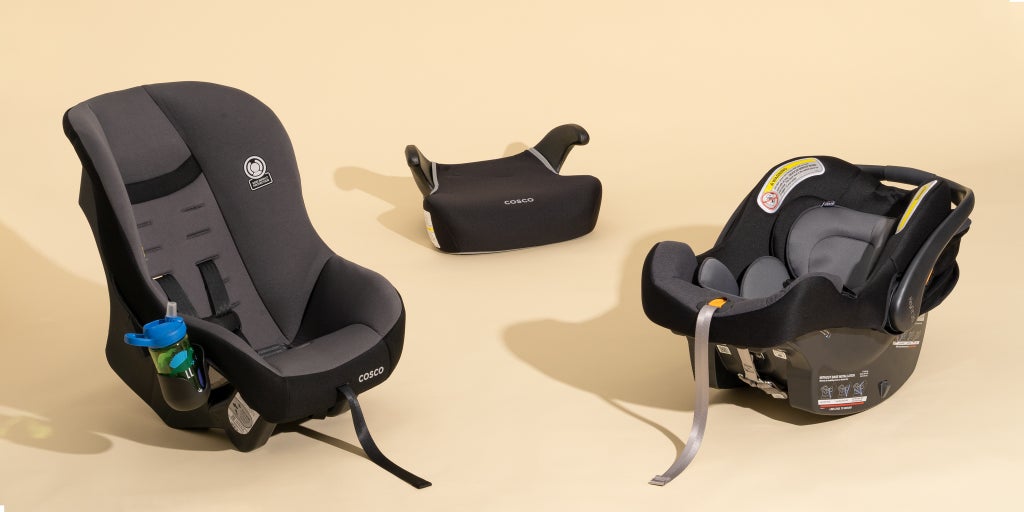Bike riding can be an empowering– and super-fun– way for children to get to institution. The very first time my 6-year-old little girl conquered the hill between our house and her college, I don’t think she stopped smiling throughout the day.
It’s likewise great for their bodies: Children ought to invest a minimum of 60 mins per day engaged in moderate to energetic exercise, according to the Centers for Illness Control and Prevention, and walking or cycling to college can even increase focus in class.
An included bonus for parents: You get to miss the gridlocked automobile drop-off line. Below’s how to help your child adventure to institution efficiently and safely.
Riding in a group might make the experience of cycling to college safer and more enjoyable. Current years have actually seen a boom (PDF) in bike buses, in which groups of children and parents plan a bike course with numerous quits and gradually and safely make their means to college (or occasionally numerous institutions). Research study has shown that vehicle drivers are much more knowledgeable about and responsive to larger teams of bikers. And also, kids may just be a lot more ecstatic to ride with a big team of buddies.
I saw that interest grow in my own city when my buddy Meghan Farrell began a once-a-week group ride to help her 8-year-old kid reach school in our Rose city, Maine, area. Her bike bus helped households from the exact same college learn more about each other. “I have actually had parents inform me that their child asks if it’s bike bus day each day of the college week,” she told me. “They like it that much.” If your area doesn’t already have a recognized bike-bus path, you could look into beginning one.
Due to the fact that younger children often tend to be more spontaneous and much less aware of traffic, the American Academy of Pediatrics recommends that kids be gone along with by a moms and dad on their walk or trip to school up until around age 10. However norms differ, and various schools have various policies for when children can come and go by themselves. Parents should use their ideal judgment to establish when their youngster is ready to ride alone, or in a kid-led team.
The basic consensus is that youngsters ought to ride on the sidewalk till they have to do with 10 years old, but some states and cities have different legislations. For example, New york city City bike law mentions that children 12 and under must ride on the sidewalk, while grownups have to ride on the road. Get to know your own community’s pathway law, and if it doesn’t have one, utilize your finest judgment when making a plan for your child.
Think about that the path you take to get to your youngster’s school by auto may not be the very best route for a bike trip. Focus on streets with less web traffic, wide pathways, bike lanes, and crossing guards. It’s a good concept to try out the course once or twice prior to institution starts, even if you’ll be accompanying your youngster on their daily trip. Explain quit indications, gaps, crosswalks, or various other markers they should know. If they’ll be riding alone, make sure they understand the route in and out before they try it on their own.
The best knowledge and equipment can make the process of cycling to school safer and much more comfortable, and it raises the chances that it’s sustainable over the long-term too.
Beginning with a bike that fits. An appropriately sized bike assists your youngster feel great and risk-free while they’re riding. REI, the company that makes our runner-up for a very first pedal bike, has a useful sizing chart online that can assist you discover the appropriate bike for your child, no matter what brand of bike you acquire.
Know your ABCs (air, brakes, chain). Find out how to do an ABC quick check (PDF), which makes use of a kid-friendly phrase to aid you and your youngster see to it their bike is in proper working order prior to they ride. Check the air in their tires, ensure the brakes are working correctly, and examine the chain, cranks, and cogs for cleanliness and tightness.
Wear a safety helmet. We suggest the Giro Tremor as the best safety helmet for the majority of school-age kids. However what’s most important is that any kind of helmet you pick fits appropriately (PDF). Putting on a headgear ought to be nonnegotiable– some states even have required bike headgear regulations for youngsters.
Dress for convenience and visibility. Children (and their accompanying grownups) need to ideally wear brilliant colors and utilize bike lights and reflectors, which help make cyclists extra visible to drivers. Make certain their right-pant leg is put into a sock or rolled up, so it will not grab on the chain (or be discolored by chain oil). You can aid a kid maneuver a crammed backpack by loading larger things like books as near to the back panel of the backpack as possible. After that tighten the shoulder straps for a tight fit, and if there’s a breast strap, make use of that, too. (Safe Routes Collaboration discusses that some bike buses utilize a parent with a bike trailer (PDF), for lugging hefty knapsacks, music instruments, or the like.).
Use hand signals and a bell. Review bike hand signals (PDF), and show them to your youngster. These are global customary practices that aid bicyclists interact with other cyclists, in addition to vehicle drivers. Instead of blinkers or brake lights, cyclists use their arms to indicate that they’re transforming, slowing down, or stopping. It’s likewise a good idea to teach your kids to ring their bell and say “passing on your left” when passing a pedestrian or another biker, and to call out dangers for the motorcyclists behind them. Pedestrians have the right-of-way on walkways; instilling some common courtesy in your young cyclist will certainly offer them well.
Look both ways. Make sure your kid knows that they need to quit at every junction, significant or unmarked, and meticulously look both methods, similar to they do when they’re walking. Some experts suggest mentor young children to stroll their bikes throughout crosswalks, however different communities have various regulations relating to bikes and crosswalks. Youngsters ought to also get in the practice of checking driveways and making certain their path is clear.
Lock it up.
Whether you reside in a town or a huge city, you’ll most likely intend to help your kid lock up their bike at school. Regrettably, bike burglary is a typical problem in the United States, and while no lock can assure burglary prevention, an excellent lock, used correctly, a minimum of inhibits or deters most prospective bike thieves.
There are four basic kinds of bike locks: U-locks, chain locks, folding locks, and cord locks. Professionals normally concur that wire locks are the least reliable because they’re much easier to cut, so we don’t recommend buying one. And while folding locks, like the one that Wirecutter recommends in our guide to the best bike locks, have some benefits, they offer much less security than a chain lock or a U-lock. The ideal lock for your youngster depends upon their age and capacity to carry heavy things, hang on to tricks, and keep in mind codes.
We like chain locks with numerical codes for the extremely youngest cyclists, as asking a 7-year-old to track an essential seems like a dish for failure. It may take a number of tries for your youngster to find out just how to utilize the code, but once they get it, it’s easy. And children chain locks normally evaluate less than U-locks, so they tend to be more manageable. (Simply make sure to list that code in situation your child forgets it.).
You can fold up a chain lock and stuff it into a knapsack or wrap it around the bike’s seat post. If your kid locks their bike to a school bike rack, they can consider just leaving their lock secured to the rack during the night to stay clear of the weight of lugging it backward and forward.
The Woom Lokki Bike Lock, like the majority of chain locks, is covered in a fabric sleeve to prevent scratches, and it is constructed from a durable steel that only a motivated bike burglar with effective tools could puncture. The Guardian Bike Lock looks virtually the same yet evaluates less.
U-locks are amongst one of the most protected kinds of bike locks. The Ottolock Partner is a lightweight U-lock that works well for older primary pupils or intermediate school youngsters. Unlike the chain locks we advise above, the Ottolock Partner is used in bright shades (orange or blue) and includes 3 tricks. At 26.5 ounces, or 1.65 pounds, it weighs concerning fifty percent as much as Wirecutter’s top-pick bike lock and a 3rd as high as our upgrade choice.
Older middle schoolers and high school kids will likely be finest offered by a choice from our guide to the best bike locks. These are heavier and extra expensive than the Ottolock Sidekick, yet they supply more protection from theft.
Once you’ve picked the best lock for your kid, instruct them the basics of how to secure a bike. You can take numerous degrees of safety preventative measures when locking your bike (like threading the lock with the frame and a wheel), so find a lock plan that stabilizes security and achievability.





